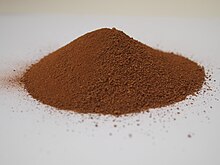Martian regolith
[9] In 2022, NASA and the U.S. National Science Foundation co-funded a multi-year grant to study the use of the bacteria Dehalococcoides mccartyi to break down perchlorates into harmless chlorides and oxygen.[10] However, the added effect of the high levels of UV reaching the surface of Mars breaks molecular bonds, creating even more dangerous chemicals which in lab tests on Earth were shown to be more lethal to bacteria than the perchlorates alone.[13] Following on from this, since 2001 NASA's Mars Exploration Program Analysis Group (MEPAG) has had a goal to determine the possible toxic effects of the dust on humans.In 2010, the group noted that although the Phoenix lander and the rovers Spirit and Opportunity had contributed to answering this question, none of the instruments have been suitable for measuring the particular carcinogens that are of concern.[14] The Mars 2020 rover is an astrobiology mission that will also make measurements to help designers of a future human expedition understand any hazards posed by Martian dust.It is believed that large quantities of water and carbon dioxide [23] ices remain frozen within the regolith in the equatorial parts of Mars and on its surface at higher latitudes.[26] High concentrations of ice in regolith is thought to be the cause of accelerated soil creep, which forms the rounded "softened terrain" characteristic of the Martian midlatitudes.In June 2008, the Phoenix lander returned data showing Martian regolith to be slightly alkaline and containing vital nutrients such as magnesium, sodium, potassium and chloride, all of which are ingredients for living organisms to grow on Earth.[28] Further testing was necessary to eliminate the possibility of the perchlorate readings being caused by terrestrial sources, which at the time were thought could have migrated from the spacecraft either into samples or the instrumentation.Lander cameras showed dust accumulating on the wheels as the rover moved and the WAE detected a drop in the amount of light hitting the sensor.The results revealed the presence of several minerals, including feldspar, pyroxenes and olivine, and suggested that the Martian regolith in the sample was similar to the "weathered basaltic soils" of Hawaiian volcanoes.[31] In December 2012, scientists working on the Mars Science Laboratory mission announced that an extensive analysis of Martian regolith performed by the Curiosity rover showed evidence of water molecules, sulphur and chlorine, as well as hints of organic compounds.On September 26, 2013, NASA scientists reported the Mars Curiosity rover detected "abundant, easily accessible" water (1.5 to 3 weight percent) in regolith samples at the Rocknest region of Aeolis Palus in Gale Crater.On Earth, dust that leaves atmospheric suspension usually gets aggregated into larger particles through the action of soil moisture or gets suspended in oceanic waters.

Mars
Perseverance
rover
– wind lifts a massive dust cloud (June 18, 2021)






(by Mars Climate Sounder )


Curiositysand duneMars sample-return missionMars roversMars orbitersperchloratesorganicbrecciaaeolian (wind) conditionsWentworth scaleradio wavesregolithbedformclastsconcretionsasteroidssatellitesmineralPerseverance roverperchloratechlorineMars roverSojournerSpiritOpportunityMars OdysseyPhoenix landercalcium perchlorateEichhornia crassipesDehalococcoidesInSightolivinepyroxenefeldsparlung diseaselunar dustcarcinogensMars 2020human expeditionX-ray fluorescencespectrometerSHERLOCRaman spectrometerin situRocknestdust stormssuperoxidegroundwater sappingcarbon dioxide hydratesCheMin analysispyroxenesCuriosity roversoil creepsoftened terrainmagnesiumsodiumpotassiumchloridechemistryChemCamMars Pathfinderbasaltic soilsHawaiian volcanoesMartian regolith simulantMars Science Laboratoryanalysiswater moleculessulphurorganic compoundsterrestrialRocknest regionAeolis PalusGale Cratermafic typefelsic typeMartian dustorganic moleculesJake M rockGlenelgmugeariteclay-bearing unitMount SharpAtmosphere of MarsDust devil tracksoptical depth tauMars Climate SounderMount Pinatubotwo rover sitessurface dustMars Global SurveyorThermal Emission Spectrometerelemental ironvan der Waals forcesMedusae Fossae FormationMartian regolith simulantsspacecraftprototypelife support systemsin-situ resource utilizationMars sample returnMars Exploration RoverHottahrock outcropRocknest 3Martian soil simulantAeolis quadrangleCarbonates on MarsComposition of MarsGeology of MarsList of rocks on MarsMineralogy of MarsScientific information from the Mars Exploration Rover missionWater on MarsMars carbonate catastropheBibcodeNew York Times3 NewsScienceSautter, V.Blaney, D.CiteSeerXWadhwa, M.IcarusEarth and Planetary Science LettersJournal of Geophysical ResearchNature Communications